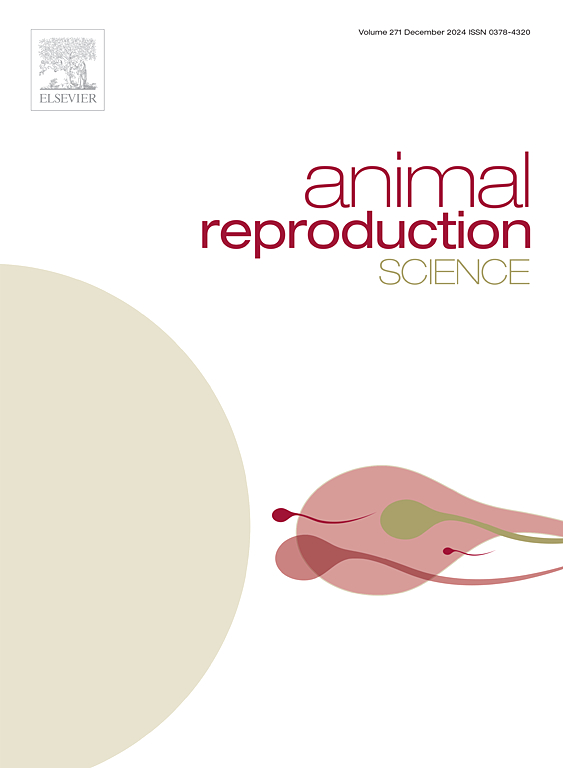De-SUMO1ylated hexokinase 1 selectively degraded by ubiquitin-proteasome pathway promotes boar sperm capacitation in vitro
IF 2.2
2区 农林科学
Q1 AGRICULTURE, DAIRY & ANIMAL SCIENCE
引用次数: 0
Abstract
This study investigates the effect of de-SUMOylated hexokinase 1 (HK1) degradation on sperm capacitation in vitro. Sperm from adult Landrace pigs was divided into three groups: non-capacitated group, capacitated group, and 16 mM 2-deoxy-D-glucose (2-DG) group. Immunoprecipitation was performed to detect the binding levels of HK1 and small ubiquitin-like modifier 1 (SUMO1) before and after capacitation. Western blotting was used to assess the degradation pathways of HK1 and tyrosine phosphorylation levels after capacitation. Immunofluorescence was employed to localize HK1 and SUMO1 in sperm. A kit was used to measure pyruvate and adenosine triphosphate (ATP) content. Fluorescent staining was used to detect reactive oxygen species (ROS) levels, zinc (Zn²⁺) levels, calcium (Ca²⁺) levels, and mitochondrial membrane potential (MMP) in sperm. Hoechst 33342 staining was used to visualize sperm nuclei and assess sperm-oocyte adhesion rates. The results showed that inhibition of HK1 activity significantly reduced pyruvate and ATP content, sperm capacitation markers (tyrosine phosphorylation, Zn²⁺), MMP, and sperm adhesion rates (P < 0.05), while significantly increasing ROS levels in capacitated sperm (P < 0.01). Immunoprecipitation and Western blotting results indicated that HK1 undergoes de-SUMOylation during capacitation and is selectively degraded via the ubiquitin-proteasome pathway (P < 0.01). Our findings suggest that de-SUMOylated HK1 activates the glycolytic pathway through ubiquitin-proteasome pathway (UPP) degradation, thereby promoting sperm capacitation. These results provide new theoretical insights into the molecular mechanisms of sperm capacitation.
泛素-蛋白酶体途径选择性降解去sumo1化己糖激酶1促进猪精子体外获能
本研究探讨了脱苏己糖激酶1 (HK1)降解对体外精子获能的影响。将成年长白猪精子分为3组:无获能组、获能组和16 mM 2-脱氧-d -葡萄糖(2-DG)组。免疫沉淀法检测获能前后HK1与小泛素样修饰物1 (SUMO1)的结合水平。Western blotting检测获能后HK1的降解途径和酪氨酸磷酸化水平。采用免疫荧光法对精子中HK1和SUMO1进行定位。用试剂盒测定丙酮酸和三磷酸腺苷(ATP)含量。荧光染色检测精子中的活性氧(ROS)水平、锌(Zn 2 +)水平、钙(Ca 2 +)水平和线粒体膜电位(MMP)。采用Hoechst 33342染色观察精核,评估精卵细胞粘附率。结果表明,抑制HK1活性可显著降低丙酮酸和ATP含量、精子获能标记物(酪氨酸磷酸化、Zn 2 +)、MMP和精子粘附率(P <; 0.05),同时显著提高获能精子中的ROS水平(P <; 0.01)。免疫沉淀和Western blotting结果表明,HK1在获能过程中经历去sumoylation,并通过泛素-蛋白酶体途径选择性降解(P <; 0.01)。我们的研究结果表明,去sumoylated的HK1通过泛素-蛋白酶体途径(UPP)降解激活糖酵解途径,从而促进精子获能。这些结果为精子获能的分子机制提供了新的理论见解。
本文章由计算机程序翻译,如有差异,请以英文原文为准。
求助全文
约1分钟内获得全文
求助全文
来源期刊

Animal Reproduction Science
农林科学-奶制品与动物科学
CiteScore
4.50
自引率
9.10%
发文量
136
审稿时长
54 days
期刊介绍:
Animal Reproduction Science publishes results from studies relating to reproduction and fertility in animals. This includes both fundamental research and applied studies, including management practices that increase our understanding of the biology and manipulation of reproduction. Manuscripts should go into depth in the mechanisms involved in the research reported, rather than a give a mere description of findings. The focus is on animals that are useful to humans including food- and fibre-producing; companion/recreational; captive; and endangered species including zoo animals, but excluding laboratory animals unless the results of the study provide new information that impacts the basic understanding of the biology or manipulation of reproduction.
The journal''s scope includes the study of reproductive physiology and endocrinology, reproductive cycles, natural and artificial control of reproduction, preservation and use of gametes and embryos, pregnancy and parturition, infertility and sterility, diagnostic and therapeutic techniques.
The Editorial Board of Animal Reproduction Science has decided not to publish papers in which there is an exclusive examination of the in vitro development of oocytes and embryos; however, there will be consideration of papers that include in vitro studies where the source of the oocytes and/or development of the embryos beyond the blastocyst stage is part of the experimental design.
 求助内容:
求助内容: 应助结果提醒方式:
应助结果提醒方式:


